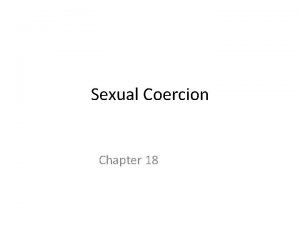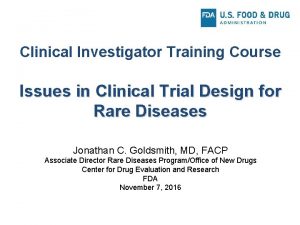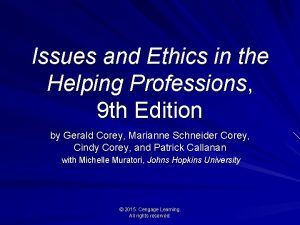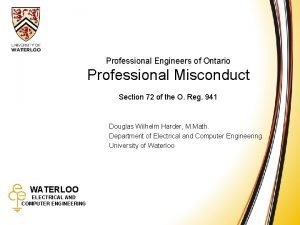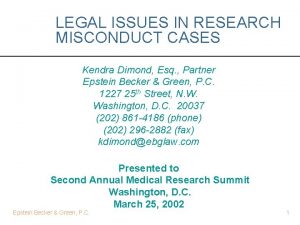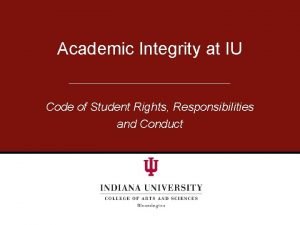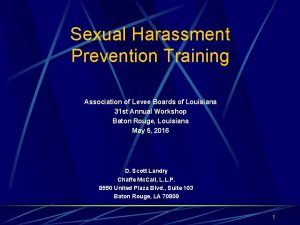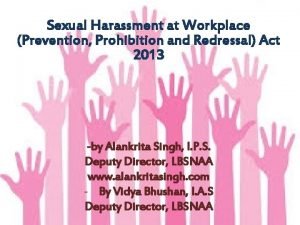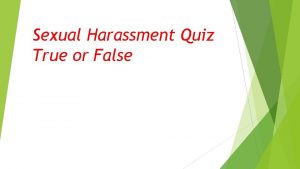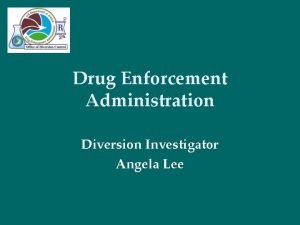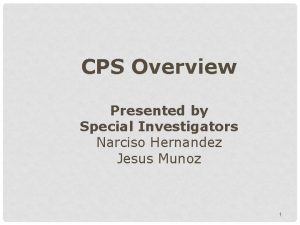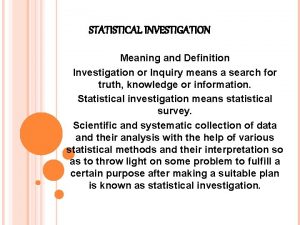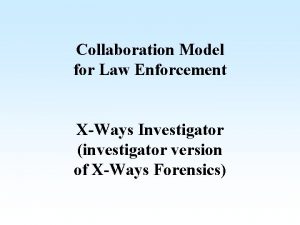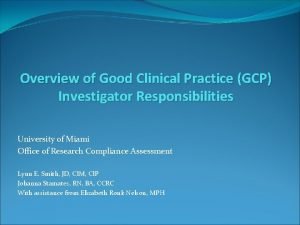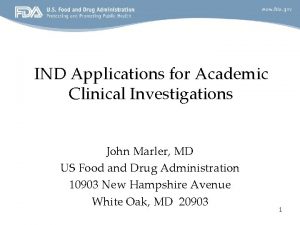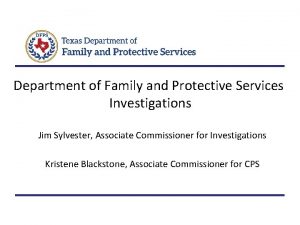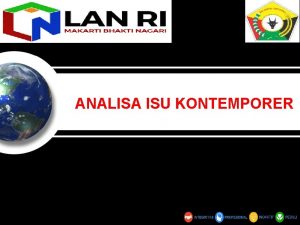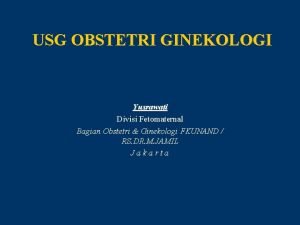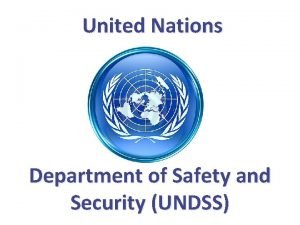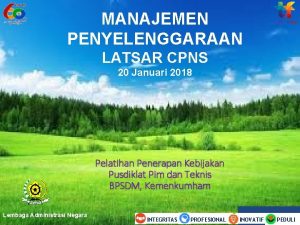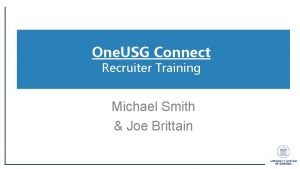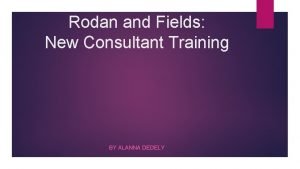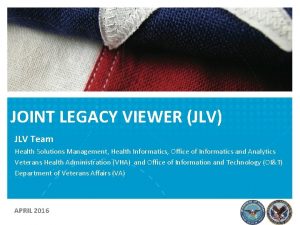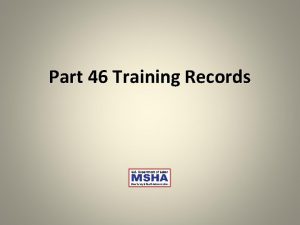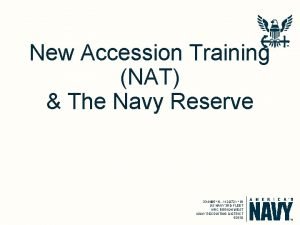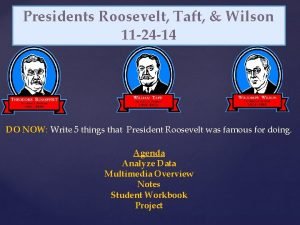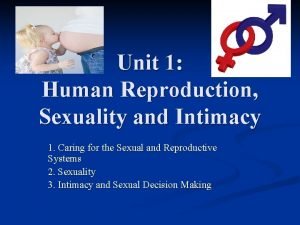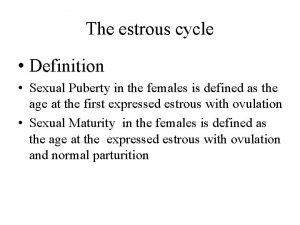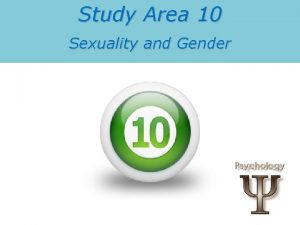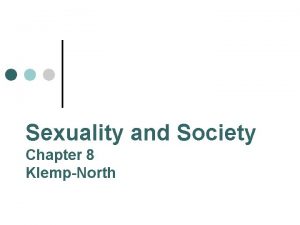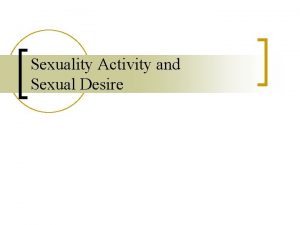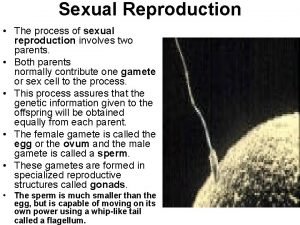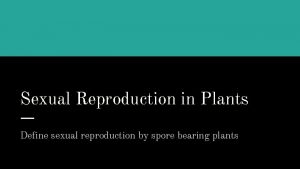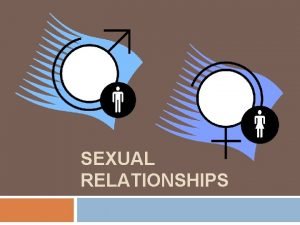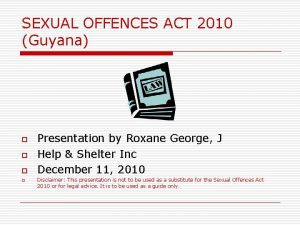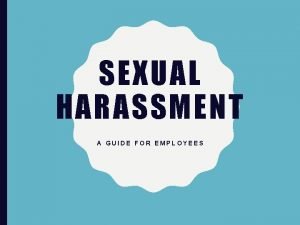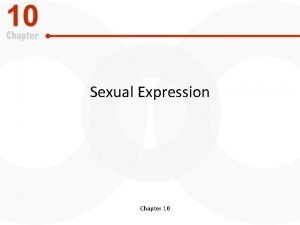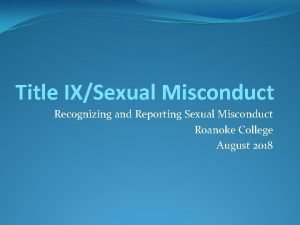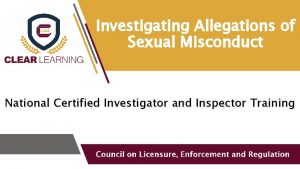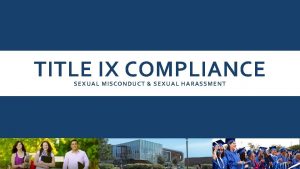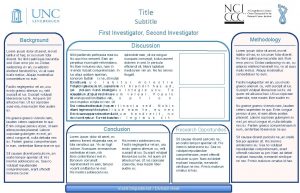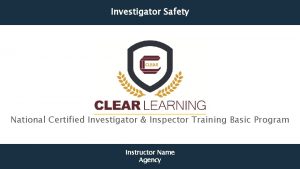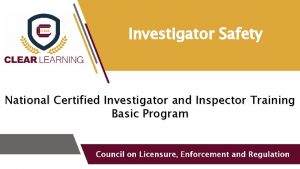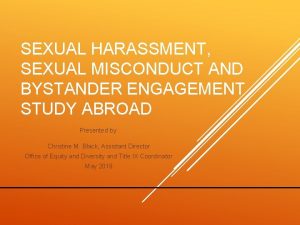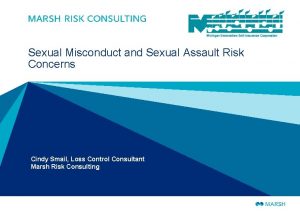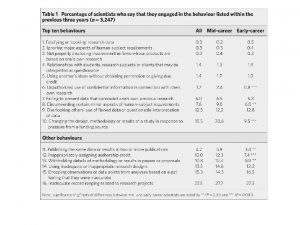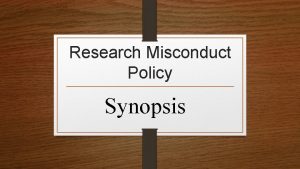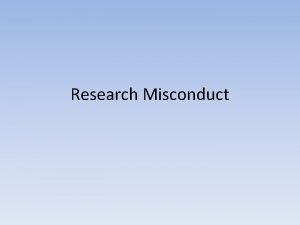USG New Sexual Misconduct Title IX Investigator Training


































![Respondent’s Awareness • The Respondent [or a Reasonable Person] must have been aware of Respondent’s Awareness • The Respondent [or a Reasonable Person] must have been aware of](https://slidetodoc.com/presentation_image_h2/a57686bb86ee223a664538a421925213/image-35.jpg)






































































- Slides: 105

USG New Sexual Misconduct & Title IX Investigator Training Na’Tasha Webb-Prather System Director for Equity & Investigations Legal Counsel Brandi Williams Equity Compliance Investigator & Trainer

Title IX Overview USG Sexual Misconduct Policy Force-Incapacity-Consent Construct Formal Investigation Process Case Studies

Who’s Here in the Room? • What’s your day job? • What do you believe it means to be an Investigator? • Does anyone have prior experience serving on panels or as an investigator? 3

Primary Function of the Investigator • Be a neutral fact finder – Hear the facts and circumstances of an alleged policy violation – Gather additional relevant information • Determine whether the evidence supports a charge of a policy violation • Communicate findings in a clear and concise manner 4

Title IX Overview

Title IX The law states that: "No person in the United States shall, on the basis of sex, be excluded from participation in, be denied the benefits of, or be subjected to discrimination under any education program or activity receiving Federal financial assistance. . . " —United States Code 6

Administrative Action on Title IX 2011 & 2014 2018 August 2020 Obama Guidance Rule Making Notice & Comment Final Rule effective Board Policy updated Trump Guidance Final Rule Issued 2017 May 2020 7

What is Sex Discrimination? Sex Discrimination Discriminatory Acts Sexual Harassment Retaliation 8

Title IX Sexual Harassment § 106. 30 • Conduct on the basis of sex that satisfies one or more of the following: – (i)An employee conditioning education benefits on participation in unwelcome sexual conduct (i. e quid pro quo); or – (ii)Unwelcome conduct that a reasonable person would determine is so severe, pervasive, AND objectively offensive that it effectively denies a person equal access to the school’s education program or activity; or – (iii) Sexual assault (as defined in the Clery Act), dating violence, domestic violence, or stalking as defined in VAWA 9

Title IX Jurisdiction - Institution’s program or activity in the United States - Institution property - Institution sponsored or affiliated events [substantial control is key] - Buildings owned or controlled by officially recognized student organizations This Photo by Unknown Author is licensed under CC BY-ND 10

System Wide Sexual Misconduct Policy 11

Sexual Misconduct Policy Title IX Other Sexually Based Behavior 12

Key Categories of Prohibited Conduct Dating Violence Sexual Misconduct Domestic Violence Sexual Exploitation Sexual Harassment Stalking Nonconsensual Sexual Contact Nonconsensual Sexual Penetration 13

USG Prohibited Conduct Definitions 14

Dating Violence committed by a person who is or has been in a social relationship of a romantic or intimate nature with the alleged victim. • Includes sexual or physical abuse • Includes threats of such abuse • The existence of a covered relationship is based on the totality of the circumstances 15

Domestic Violence committed by: • a current spouse, former spouse or intimate partner • a person whom shares a child • a person who is cohabiting with or cohabitated with the alleged victim 16

Stalking Engaging in a course of conduct directed at a specific person that would cause a reasonable person to fear for his or her safety or the safety of others OR suffer substantial emotional distress. • • • Can be direct actions or through third parties Could include the use of devices or other methods Includes following, monitoring, observing, surveilling, threatening, communicating to or about a person, or interfering with a person’s property 17

Sexual Exploitation Taking non-consensual or abusive sexual advantage of another for one’s own advantage or benefit, or for the benefit or advantage of anyone other than the one being exploited. Examples include: • Non-consensual photos, videos, or audio of sexual activity • Non-consensual distribution of photo, video, or audio of sexual activity, even if the sexual activity was consensual • Intentionally and inappropriately exposing one’s breast, buttocks, groin, or genitals in non-consensual circumstances 18

Nonconsensual Sexual Contact Any physical contact with another person of a sexual nature without the person’s consent. Includes: • Touching of another’s intimate parts (genitalia, groin, breasts, buttocks) • Touching a person with one’s own intimate parts; or • Forcing a person to touch his or her own or another person’s intimate parts 19

Nonconsensual Sexual Penetration Any penetration of another’s body parts without the person’s consent. Includes: • Penetration of the vagina, anus, or mouth by a penis, object, tongue, finger, or other body part • Contact between the mouth of one person and the genitals or anus of another person 20

Sexual Harassment (Student on Student) Unwelcome verbal, nonverbal, or physical conduct based on sex (including gender stereotypes), determined by a Reasonable Person to be so severe, pervasive, and objectively offensive that it effectively denies a person equal access to participate in or to benefit from an institutional education program or activity 21

Sexual Harassment (Other) Unwelcome verbal, nonverbal, or physical conduct, based on sex (including gender stereotypes) that may be any of the following: • Implicitly or explicitly a term or condition of employment status in a course program or activity • A basis for employment or education decisions; OR • Sufficiently severe, persistent, or pervasive to interfere with one’s work or educational performance creating an intimidating, hostile, or offensive work environment • Note: Behavior may rise to the level of a Title IX violation 22

Understanding The Force-Incapacity-Consent Construct

Overview of the Construct 1. Was force used by the Respondent to engage in the sexual activity? 2. Was the Complainant Incapacitated? a) Did the Respondent know OR b) Should the Respondent have known that the Complainant was incapacitated? 3. What clear words or actions by the Complainant gave the Respondent indication that the sexual activity was mutually agreed upon? 4. Was the Complainant’s consent withdrawn during the sexual activity? 24

Consent • Words or actions that show a knowing and voluntary willingness to engage in a mutually agreed upon sexual activity • Past consent ≠ Present consent • The scope of consent matters • Can be invalidated by: force, intimidation, incapacitation, or withdrawal 25

Force • Was force used by the Respondent to engage in the sexual activity? • Because consent must be voluntary (an act of free will) consent cannot be obtained through use of force • Types of Force to consider: o Physical violence -- hitting, restraint, pushing, kicking, etc. o Threats -- anything that gets the other person to do something they wouldn’t ordinarily have done absent the threat 26

Force Continued • Intimidation - an implied threat that menaces and/or causes reasonable fear • Coercion – the application of an unreasonable amount of pressure for sexual access • Consider: – – Frequency Intensity Duration Isolation 27

Force Analysis • Did the Respondent utilize force or intimidation to engage in the sexual activity with the Complainant? – If yes = violation of policy – If no = Move on with the analysis 28

Consent and the Role of Alcohol and Drugs 29

Incapacitation • Physical and/or mental inability to make informed, rational judgments – Could the Complainant make rational, reasonable decisions ? – Could the Complainant appreciate the situation and address it consciously? • More than mere intoxication or drunkenness 30

Determining Incapacitation • Incapacitation is a determination that will be made after the incident in light of all the facts available • Assessing incapacitation is very fact dependent analysis of the incident in question • Various forms of incapacity – – Alcohol or other drugs Mental/cognitive impairment Injury Sleep 31

Two-Part Incapacitation Analysis Part One • Was the Complainant incapacitated? Part Two • Did the Respondent know of the Complainant’s incapacity? – Or would a Reasonable Person have known? Subjective analysis based on the facts surrounding the incident Objective analysis based on the facts surrounding the incident 32

Common Factors that Impact the Effect of Alcohol l Rate of consumption l Enzymes, hormones, water in body l Strength of drink l Medications l Food in the stomach l Illness & dehydration l Body Weight l Fatigue l Body Type – body fat percentage l Caffeine l Gender l Genetics 33

Possible Signs of Incapacitation • Lack of control over physical movements – Ex. Inability to dress or walk without assistance • Lack of awareness of circumstances or surroundings • Inability to communicate coherently • Vomiting • Total or intermittent unconsciousness 34
![Respondents Awareness The Respondent or a Reasonable Person must have been aware of Respondent’s Awareness • The Respondent [or a Reasonable Person] must have been aware of](https://slidetodoc.com/presentation_image_h2/a57686bb86ee223a664538a421925213/image-35.jpg)
Respondent’s Awareness • The Respondent [or a Reasonable Person] must have been aware of the Complainant’s incapacity • The Respondent’s own intoxication does not negate their obligation to comply with policy standards 35

Incapacitation Analysis • If the Complainant was not incapacitated, move on to the 3 rd question. • If the Complainant was incapacitated, but: – The Respondent did not know it = analysis fails. Move on to the 3 rd question. – The Respondent should not have known it = analysis fails. Move on to 3 rd question. • If the Complainant was incapacitated, and: – The Respondent actually knew it = violation of policy – The Respondent should have known it = violation of policy 36

Consent What clear words or actions by the Complainant gave the Respondent permission for the specific sexual activity that took place? 37

Consent Is… • • • Informed (knowing) Voluntary (freely given) Active (not passive) Clear words or actions Indicates permission to engage in mutually agreed upon (sexual) activity 38

Rules to Remember • No means no, but nothing also means no Silence and passivity do not equal permission • To be valid, consent must be given prior to or contemporaneously with the sexual activity • Consent can be withdrawn at any time 39

Withdrawal • Remember consent can be withdrawn at any time • The person withdrawing consent is expected to clearly communicate with words or actions they are withdrawing consent • Other person is required to cease sexual activity until consent is regained 40


Overview of Investigator Responsibilities Title IX Investigation Overview Weighing & Evaluating Information Writing the Investigation Report

Investigator Roles & Responsibilities 43

Role of the Investigator • Fair and unbiased review of matter • Follow the Policy – Standard of proof – Avoid burden shifting • Make a preliminary determination regarding the violation(s) and possibly recommend sanction(s) 44

Recognize and Avoid Your Own Bias l Role of Alcohol l Ethnicity l Own experiences… l Nature l Religion l Student-Athletes l Fraternity/Sorority l International of the Violation Life Students l Academic Field of Study/Major l Politics l Sex/Gender l Attitude l Gender l Others? Identity or religious beliefs l Race 45

Title IX Investigation Overview

Steps in the Investigation Process • • Report is made Intake by Title IX Coordinator Filing of a Formal Complaint Assignment to the Investigator Development of an Investigation Plan Fact Gathering Analysis of Information & Report Writing • Case Resolution/Adjudication 47

Complaint Intake • Typically handled by the Title IX Coordinator • Determination that the alleged conduct falls within the Sexual Misconduct Policy • May determine which process to follow • Identification of the involved parties • IS NOT THE INVESTIGATION 48

Interim Measures • May be implemented at any point by the Title IX Coordinator • Must be available to both parties • Must be implemented in an equitable manner designed to protect the parties and/or the campus community Examples Housing changes No Contact Directive Class changes Employment schedule or location changes Administrative Leave Interim Suspension* • *Require approval of System Director 49

Formal Complaint § 106. 30 • A document filed by a Complainant OR signed by the Title IX Coordinator • Alleges Sexual Harassment (Title IX) • Requests an investigation • Note: must be filed while the Complainant is participating in or attempting to participate in an education program or activity 50

Developing an Investigation Plan • Review the Complaint Intake and any available information • Review the Sexual Misconduct Policy • Review relevant investigation procedures • Determine order of interviews • Gather preliminary evidence • Develop preliminary questions 51

Key Aspects in the Investigation Process • Written notice to parties – – – Pending investigation Possible charges Possible sanctions Available support resources Identify the assigned investigator • Opportunity for written response

Key Aspects in the Investigation Process • Parties’ right to an Advisor – May be an attorney – Purpose: provide advice and counsel • Parties’ right to remain silent or otherwise not participate – Non-response = general denial – Non-response ≠ adverse inference 53

Fact Gathering d e d i v o Pr ence Evid Interviews Addit ional Evide nce 54

Interview Strategies • • Set a professional non-accusatory tone Introduce yourself and outline your role Acknowledge what emotions they may be experiencing Review the amnesty and retaliation policies Outline an expectation of truthfulness Discuss confidentiality Reminder that there may be follow-up interviews 55

Retaliation and Amnesty Policies Anti-Retaliation Policy • Applies to students and employees equally • Individuals involved in the investigation should be free from any adverse action due to their participation Amnesty Policy • Only applies to students • Designed to foster candor during investigations • Personal usage of drugs or alcohol will not be held against them in disciplinary matters 56

Effective Questioning • Questions should be used to determine: • • • Who What When Where How • Be mindful of how a question could be perceived and develop them with caution 57

Effective Questioning What are your goals? What are NOT your goals? • Learn the facts • Satisfying your curiosity • Establish a timeline • Answering every unknown to • Determine what is more get the “Truth” likely than not to have occurred [if possible] 58

Effective Questioning Tips • Prepare preliminary/guiding questions in advance • Ask open-ended questions to start the conversation – What are you able to remember about…? – Tell me more about…. – Help me understand your thoughts when…. • LISTEN, ask follow-up questions at the end – Targeted and specific questions • If you get stuck conduct a recap 59

Additional Interviewing Tips • Don’t be afraid of silence • Don’t be afraid to ask for clarification • Take breaks if necessary • Maintain your professionalism at all times 60

How to Deal With… A Challenging/Reluctant Participant • Address their concerns A Lying Participant • Ask them to reconcile inconsistent statements • Remain calm and professional • Try to determine motivation for lying [fearful, protecting a friend, embarrassed etc. ] • Explain the advantages of cooperating 61

Note-Taking • Handwritten or electronic record of the interview – Remember you are creating a publicly available record – Try to include verbatim statements • Include the date and names of all those present 62

Note-Taking Considerations • Use of audio recordings • Sending an interview summary for the participant to review and edit Tip: Schedule time after an interview to review and type narrative summary 63

Evidence Gathering • Think of all the places and sources of information – Involved parties, witnesses, physical locations, social media etc. – Be timely • Document who provided what and when • Consider verifying the evidence provided – Phone numbers, social media accounts, etc. 64

Understanding Evidence • Formal rules of evidence do not apply. If the information is considered relevant to prove or disprove a fact at issue, it should be admitted. If credible, it should be considered • Evidence is any kind of information presented with the intent to prove what took place • Certain types of evidence may be relevant to the credibility of the witness, but not to the charges 65

Understanding Evidence Thresholds 66

Types of Evidence Documentary evidence (supportive writings or documents) Electronic evidence (photos, text messages, videos) Real evidence (physical object) Direct or testimonial evidence (personal observation or experience) Circumstantial Evidence (not eyewitness, but compelling) Hearsay Evidence (statement made outside the hearing, but presented as important information) • Character Evidence (generally of little value or relevance) • • • 67

Weighing Evidence • Weighing evidence means assessing the impact of the information • The following factors impact the assessment: – – Relevance Reliability Persuasiveness Bias 68

Weighing Evidence: Impact Factors • Relevance – Must relate to the incident at issue and be of sufficient value in the overall determination – Must be offered by an individual with actual knowledge of the event Irrelevant • Questions and information regarding the Complainant’s sexual history or sexual predisposition unless to prove – Someone else other than the Respondent committed the alleged misconduct – Consent between the parties 69

Weighing Evidence: Impact Factors • Reliability – Information that can be trusted – Comes from individuals who are able to have assumed the role they claimed to have or those with actual training or experience to support their claim of expertise • Persuasiveness – Induces others to believe through understanding; tries to convince – Must be believable, consistent, and establishes a dependable narrative – Note: be mindful of the rehearsed narrative 70

Weighing Evidence: Impact Factors • Bias – Understand who the person is and their relationship to the parties and incident at issue – Bias can manifest in multiple ways: • Towards the parties • Towards the incident • Towards the process This Photo by Unknown Author is licensed under CC BYSA-NC 71

Credibility • “To assess credibility is to assess overall the extent to which you can rely on a witness’ testimony to be accurate and helpful in your understanding of the case” – Credible is not synonymous with the absolute truth – Memory errors do not necessarily destroy a witness’ credibility, nor does some evasion or misleading – Refrain from focusing on irrelevant inaccuracies and inconsistencies • Potential Assessment Factors – Demeanor – Non-cooperation – Logic/Consistency – Corroborating evidence 72

Other Evidentiary Exclusions • Legally privileged information is protected • A party’s treatment records cannot be used without their voluntary, written consent • Duplicative evidence may be deemed irrelevant • If an individual does not submit to cross examination, at a Title IX hearing, their statements cannot be relied upon 73

Understanding Evidence Thresholds 74

Avoid Common Pitfalls • Interview each party and witness separately* • Apply the correct policy • Maintain your sensibilities – Difficult parties – Attorneys 75

Writing the Investigation Report

The Investigation Report • Executive Summary • Relevant Policy Provisions • Information Gathered During the Investigation • An Analysis of the Information Gathered • Recommendations for Informal Resolution OR Conclusion • Investigation Timeline • Necessary Attachments 77

Basic Formatting • • • University Letterhead Date Title of Document Investigator Name(s) Names of the Involved Parties 78

Executive Summary • Big picture investigation information – Who reported the incident? – To whom did they report? – When did they report? – Who was assigned to investigate? – How was the investigation conducted? – What were the overall findings of the investigation? • Noteworthy occurrences 79

Relevant Policy Provisions • Copy and paste verbatim RELEVANT portions • Footnote link to full policy or provide as attachment 80

Information Gathered During The Investigation • Narrative summaries of information NOT transcriptions – Laid out in a logical manner – Limit witness portions to information relevant to analysis • Include quotes where deemed appropriate • Adopt one writing style • Discuss individuals not interviewed 81

Information Gathered During The Investigation • Discuss individuals not interviewed • Discuss any other evidence gathered and the source even failed attempts • TIP: Schedule time after each interview to begin writing narrative summary 82

Investigative Findings/Analysis • A synthesis of the information gathered in light of our policy • Walk through the policy violation • Remember: You’re a NEUTRAL fact-finder – Include not only corroborating information but also exculpatory information • Credibility Assessments 83

Walking Through Policy Violations Nonconsensual Sexual Contact – Was there physical contact of a sexual nature? – Was there consent? – Was the consent invalid because of: • Force • Intimidation or Coercion • Incapacitation – Was the consent withdrawn? 84

Walking Through Policy Violations Incapacitation – Part One = Subjective Test • Physical and/or mental inability to make informed decisions • SOME Signs: unconsciousness, lack of control of physical movements, inability to communicate clearly – Part Two = Objective Test • Judged from a Reasonable Person’s perspective 85

Recommendations for Informal Resolution/ Conclusion • Short and sweet • Based on the totality of the evidence a preponderance of the evidence supports/does not support a charge of (insert policy violation) • Remember: NOT ISSUING FINDINGS OF RESPONSIBILITY • Broad range of sanctions at play 86

Determining Appropriate Sanctions • “Must be made as a proportionate response to the violation. ” • Should prevent the recurrence of sexual misconduct • Should remedy the effects of the sexual misconduct 87

Common Sanctions l Warning l Service l Probation l Online l Loss l Alcohol of Privileges l Counseling l No Contact l Residence Hall Relocation, Suspension or Expulsion l Limited Access to Campus Hours Education & Drug Assessment and Counseling l Termination l Suspension* l Expulsion* *Must be supported by substantial evidence at the hearing 88

Understanding Substantial Evidence • Required to suspend or expel a student • MUST be able to clearly state what evidence exists to support the finding • Cannot be merely a feeling! 89

Investigation Timeline • Procedural History • Key dates and events throughout the process • Does not have to be a narrative 90

Necessary Attachments • Documentary Evidence • Written Statements • Optional: Full Policy 91

Optional Aspects of the Investigative Report • Incident Timeline • Incapacitation Timeline • Chart of Involved Parties • Disputed v. Undisputed Facts 92

Key Aspects in the Investigation Process • Parties right to review and respond to the investigation report – Provide adequate and equitable time • Sharing the final investigation report – The parties (and advisor*) – Hearing Panel 93

Things to Avoid • Merely transcribing interviews • Writing a one-sided report • Steering or otherwise influencing the hearing proceedings • Assuming reader knowledge 94

The Resolution/Adjudication Process

Informal Resolution • Available throughout the investigation process • The nature of the incident permits a less formal approach • The institution determines that informal resolution is in the best interest of the parties and the campus community • Both parties AND the institution have to agree to the terms • Handled by the Title IX Coordinator 96

The USG Adjudication Processes Students • All matters not informally resolved will be heard by a Hearing Panel Employees • Title IX matters not informally resolved will be heard by a designated decision-maker – Single decision-maker OR panel • Hearing Panels comprised of trained faculty and staff • Sexual Misconduct matters not informally resolved will be resolved according to previously established procedures – Institutions may choose to offer a hearing 97

Live Hearing § 106. 45(b)(6) • The Final Rule mandates a bifurcated process • Final determinations of responsibility and sanctions are made by decision-makers – CANNOT be the Title IX Coordinator or assigned investigator • New due process considerations – Cross examination – Relevancy determinations – Impact of party or witness refusal to submit to cross-examination • Institutions can establish rules of decorum 98

Title IX Hearings Sexual Misconduct Hearings • Advisors required to conduct cross examination • Hearing Panelist or Officer performs all questioning • Relevancy determinations must be made before a question may be answered • Relevancy determinations are made before and during the hearing • If an individual does not submit to • Panelists permitted to rely on statements provided during the cross examination panelists may hearing and in the investigation not rely on their statements report 99

Typical Order of a Hearing • Opening by Decision Maker • Opening statements by both parties • Questioning of the Complainant – By the hearing panel or chair – By other party (through their advisor or hearing panel/chair) • Questioning of the Respondent • Questioning of any Witnesses – By the hearing panel or chair – By other party (through their advisor or hearing panel/chair) • Closing statements by both parties • Closing by Decision Maker – By the hearing panel or chair – By other party (through their advisor or hearing panel/chair) 100

Appeals • Parties will continue to have both institutional level and Board level appeal opportunities • Grounds for an appeal: – New information – Procedural Error • Ex. Bias or conflict of interest of Title IX personnel – Finding inconsistent with the weight of the information This Photo by Unknown Author is licensed under CC BY-NC-ND 101

Additional Considerations 102

Retaliation § 106. 71 • Who is protected: Reporters, Complainants, Witnesses, Respondents, even those who choose to not participate • What is protected: Intimidation, threats, coercion, discrimination – Ex. Charging individuals for code of conduct violations that arise out of the same facts or circumstances – Ex. Not keeping the identity of the Complainant, Respondent, or any witnesses confidential 103

Record Keeping § 106. 45(b)(10) • 7 -year records retention mandate: – Reports [supportive measures, why not deliberately indifferent and what measures taken to restore or preserve equal access] – Investigations [determinations, recording of hearing, sanctions and remedies implemented] – Appeals – Informal resolutions [results] – Training materials This Photo by Unknown Author is licensed under CC BY-SA-NC 104

 Sexual misconduct meaning
Sexual misconduct meaning Clinical investigator training program
Clinical investigator training program Ba mid career fellowship
Ba mid career fellowship Fabrication meaning in research
Fabrication meaning in research Off duty misconduct
Off duty misconduct Ignoring evidence of peer misconduct is:
Ignoring evidence of peer misconduct is: Professional misconduct regulation
Professional misconduct regulation Ori research misconduct
Ori research misconduct Scientific misconduct in research
Scientific misconduct in research Academic misconduct iu
Academic misconduct iu Louisiana sexual harassment training
Louisiana sexual harassment training Sexual harrasment prevention training
Sexual harrasment prevention training Sexual abuse quiz
Sexual abuse quiz Sexual harassment training quiz
Sexual harassment training quiz Wsu sexual harassment training
Wsu sexual harassment training Prefatory part of report
Prefatory part of report Title title
Title title Shared investigator platform home
Shared investigator platform home Did investigator assign exposures
Did investigator assign exposures Rough sketch vs final sketch crime scene
Rough sketch vs final sketch crime scene Dea diversion investigator
Dea diversion investigator Craigslist private investigator
Craigslist private investigator Cps special investigator
Cps special investigator Biotechnology explorer gmo investigator kit
Biotechnology explorer gmo investigator kit Define statistical investigation
Define statistical investigation Child family investigator
Child family investigator Early stage investigator nih
Early stage investigator nih X-ways investigator
X-ways investigator Userra vets investigator
Userra vets investigator Investigator meeting services
Investigator meeting services Invasive species investigator worksheet
Invasive species investigator worksheet Social media forensics investigator
Social media forensics investigator Invasive species investigator worksheet
Invasive species investigator worksheet Gcp investigator responsibilities
Gcp investigator responsibilities John marler fda
John marler fda Gmo investigator kit
Gmo investigator kit Investigator photos
Investigator photos Ontario ombudsman investigator
Ontario ombudsman investigator Swf investigator
Swf investigator Chin interactive investigator
Chin interactive investigator Office of the correctional investigator
Office of the correctional investigator Jim sylvester dfps
Jim sylvester dfps Lesi hipoekoik
Lesi hipoekoik Perksatwork tmobile
Perksatwork tmobile Paweł gajkowski usg
Paweł gajkowski usg Usg one connect
Usg one connect Epitroklear bölge neresi
Epitroklear bölge neresi Obraz zamieci śnieżnej w usg
Obraz zamieci śnieżnej w usg Paweł weiss usg
Paweł weiss usg Login nomadix 1111 usg
Login nomadix 1111 usg Usg ecore
Usg ecore Maluszek plus medicover
Maluszek plus medicover Teknik tapisan isu adalah
Teknik tapisan isu adalah Analisis pohon masalah
Analisis pohon masalah Contoh diagram pohon masalah
Contoh diagram pohon masalah Alpha and beta angle in ddh
Alpha and beta angle in ddh Mola hidatidiforme
Mola hidatidiforme Gambar usg janin 8 minggu
Gambar usg janin 8 minggu Usg table
Usg table Undss usg
Undss usg Contoh rancangan aktualisasi
Contoh rancangan aktualisasi Naciek okołowyrostkowy
Naciek okołowyrostkowy One usg
One usg Title v air permit training
Title v air permit training Lady macbeth calls on supernatural powers to
Lady macbeth calls on supernatural powers to Training is expensive without training it is more expensive
Training is expensive without training it is more expensive Metode of the job training
Metode of the job training Aggression replacement training facilitator training
Aggression replacement training facilitator training New equipment training
New equipment training Welcoming new board members
Welcoming new board members Herbalife income plan
Herbalife income plan Rodan and fields tax write offs
Rodan and fields tax write offs Joint legacy viewer
Joint legacy viewer New miner training record/certificate
New miner training record/certificate New consultant training
New consultant training New accession training navy
New accession training navy New starter training
New starter training You control your destiny you don't need magic to do it
You control your destiny you don't need magic to do it New york, new jersey, pennsylvania, and delaware
New york, new jersey, pennsylvania, and delaware Fresh oil, new wine scripture
Fresh oil, new wine scripture Marquee cinemas - orchard 14
Marquee cinemas - orchard 14 Strengths and weaknesses of the articles of confederation
Strengths and weaknesses of the articles of confederation New-old approach to creating new ventures
New-old approach to creating new ventures What forces are defining the new marketing realities
What forces are defining the new marketing realities Njbta
Njbta New classical macroeconomics
New classical macroeconomics Chapter 16 toward a new heaven and a new earth
Chapter 16 toward a new heaven and a new earth Leanne keene french ambassador arrives from paris
Leanne keene french ambassador arrives from paris New classical and new keynesian macroeconomics
New classical and new keynesian macroeconomics Roosevelt taft and wilson venn diagram
Roosevelt taft and wilson venn diagram Wichita area sexual assault center
Wichita area sexual assault center Reproduction in humans
Reproduction in humans Sexual abuse signs and symptoms
Sexual abuse signs and symptoms Definition of sexual maturity
Definition of sexual maturity Secondary sexual characteristic
Secondary sexual characteristic The effect of the sexual counterrevolution was
The effect of the sexual counterrevolution was Deflationary theory
Deflationary theory Sexual responce cycle
Sexual responce cycle Sexual reproduction
Sexual reproduction Sexual reproduction stages
Sexual reproduction stages Define sexual reproduction
Define sexual reproduction Section 1 meiosis
Section 1 meiosis Types of sexual relationships
Types of sexual relationships Guyana sexual offences act
Guyana sexual offences act Objectives of sexual harassment
Objectives of sexual harassment Common female sexual fantasies
Common female sexual fantasies
